ITC litigation and licensing
Michael Sandonato of Fitzpatrick Cella Harper & Scinto revealed that the total number of initiated ITC 337 investigations was down in 2015, to 36 from 40 in 2014. This compares with 41 in 2013 and 36 in 2012. All of these years were way down on the peak of 69 in 2011 and 55 in 2010.
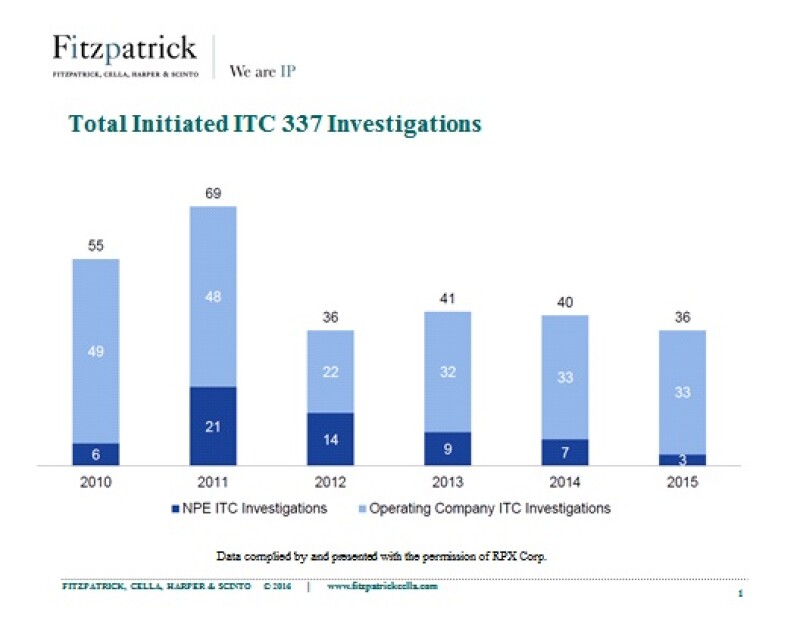
Sandonato noted advantages to bringing ITC cases.“The first is speed – you can get your remedy much more quickly at the ITC if you are successful. At the ITC you get to trial on average in about nine months – which is incredibly fast. You get your remedy about six months after that, so all in you are talking about a year and three months to get your exclusion order.”
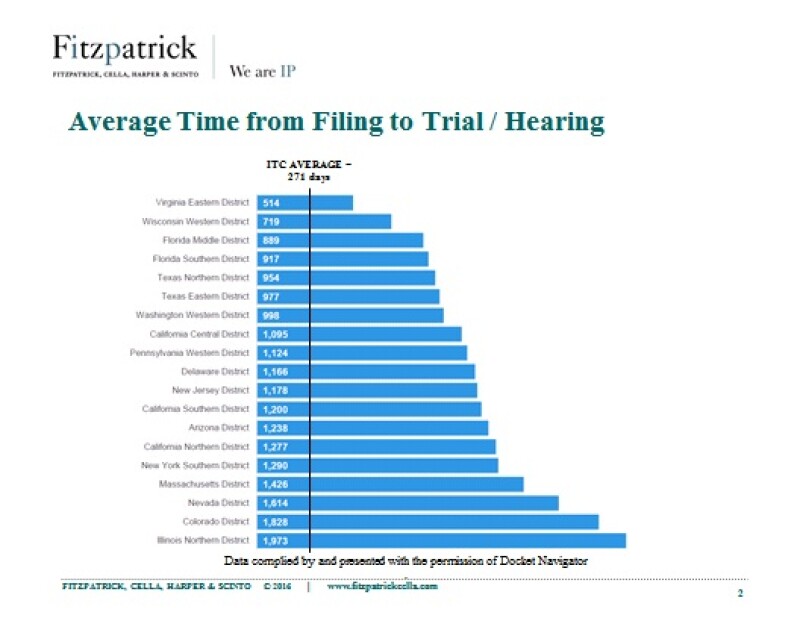
Melissa Finocchio of Intellectual Ventures noted some challenges: “ITC litigation is super expensive. It is the sport of kings, and it is not to be done lightly. A lot of that expense is front loaded before you even know if your investigation is going to be taken up by the Commission.”
Finocchio also aired frustration with the ITC being very strict about confidential information, saying it will regularly close the court room. “The problem is over designation by the parties. Stop over designating!” Monisha Deka, investigative attorney at the ITC, added: “The judges are pretty upset with the confidential information designation too.”
Patent reform in the US
Megan Woodworth of Venable noted the effect that December 2015’s amendments to the Federal Rules of Procedure is having in patent complaints. “Complaints do have slightly more information. It is now more typical that at least one claim and at least one product is identified.” She added: “I have seen a few complaints filed post December that actually have claim charts attached to them. That is something that was very rare when the standard was just Form 18.”
Matt Levy of the Computer and Communications Industry Association, noted, however, that it has not had any effect on judge’s orders regarding discovery yet. Woodworth noted more generally that judges already believed the discovery standard was the rule: “Proportionality was a concept that happened in the advisory notes at least.”
Woodworth noted the effect the Supreme Court’s 2014 Octane Fitness ruling has had on motions for attorneys fees. “What we have seen compared with the five years previous to Octane is a 40% increase in number of motions filed seeking exceptional case finding and attorneys fees. The statistics suggest somewhere between a 10% and 15% increase in the number of motions that have been granted at least in part,” she said.
Michele Van Patten Frank of Venable noted regarding Octane: “We not seeing a reduction in [case] filing but we are seeing plaintiffs being more willing to resolve the case and for lower amounts.”
Uncertainty of patentable subject matter: software and business method patents
The Supreme Court has waded back into patent eligibility in recent years through Bilski v Kappos in 2010, Mayo v Prometheus in 2012 and CLS Bank v Alice in 2014. The Federal Circuit, district courts, and PTAB have all had to respond to Alice through rulings and the USPTO has responded through interim guidance that introduced a test for eligibility.
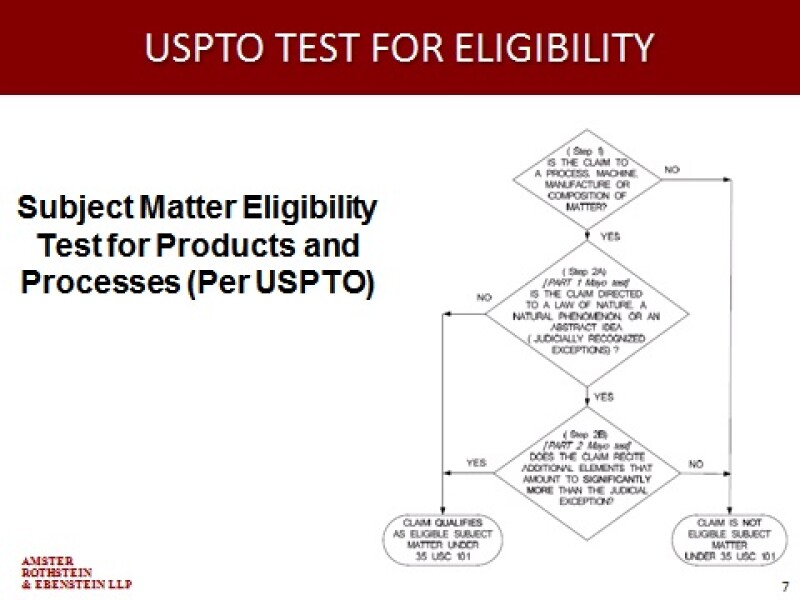
Panellists expressed dissatisfaction with the new test. “It really isn’t a test at all – anything in a claim is an abstract idea,” said Ken Corsello, IP counsel at IBM. Charles Macedo, partner at Amster Rothstein & Ebenstein added sarcastically: “We have this beautiful test but no rationale for how it is applied.”
Macedo gave an overview of pending Supreme Court petitions. These include Retirement Capital Access Mgm’t v US Bancorp and Michelle Lee, which asks: 1) Whether subject matter eligibility under 35 USC§101 is a ground specified as a condition for patentability under 35 USC § 282(b)(2), and 2) Whether the Board errs when it invalidates issued patent claims posing no risk of pre-emption under the abstract idea exception to patent eligibility.
Other cases pending include Ariosa Diagnostics v Sequenom, which asks whether a novel method patent-eligible under §101 and Joao Bock Transaction System Jack Henry & Assoc, which appeals whether the district court and Federal Circuit erred under the Mayo/Alice test for patentability under 35 USC § 101.
Post-grant proceedings before the PTAB
The institution rate for PTAB petitions has fallen into the mid-60s, with panellists believing it will be more stable from now. “That is probably about where we will be going forward,” said Laura Sheridan of Google.
PTAB Judge Christopher Crumbley noted one influence on the drop in institution rate: “Everyone has a different theory. One thing I have seen is that the sophistication in the patent owner responses has increased, with greater emphasis on more procedural aspects – those are more effective in the institution phase.”
Google’s Sheridan notedestoppel “is probably the number one factor in deciding what you want to do”. She added: “The proceedings are very fast. If you don’t think you can win, you should not bring these challenges because if you doubt the strength, they [the PTAB] will see right through it.”
During oral hearing, the panel warned against relying on large PowerPoint presentations because the Board will not let you get through them. “I have seen oral hearings where they had a 70-page presentation and they got up to number seven,” said moderator Eugene Perez of Birch Stewart Kolasch & Birch. “The questions are very technical – you’ve got to know the art.”
PTAB judge Crumbley gave some pointers for how judges view the oral hearings. “I rarely go in with a pre-conceived notion,” he said. He also revealed a pet peeve: “I’ve had people recite the claim to me – I know the claim!” In addition, “knowing the record is extremely important,” he said. “No new arguments are permitted. If it sounds new and you can’t point us to it in the brief we are not going to allow it.”
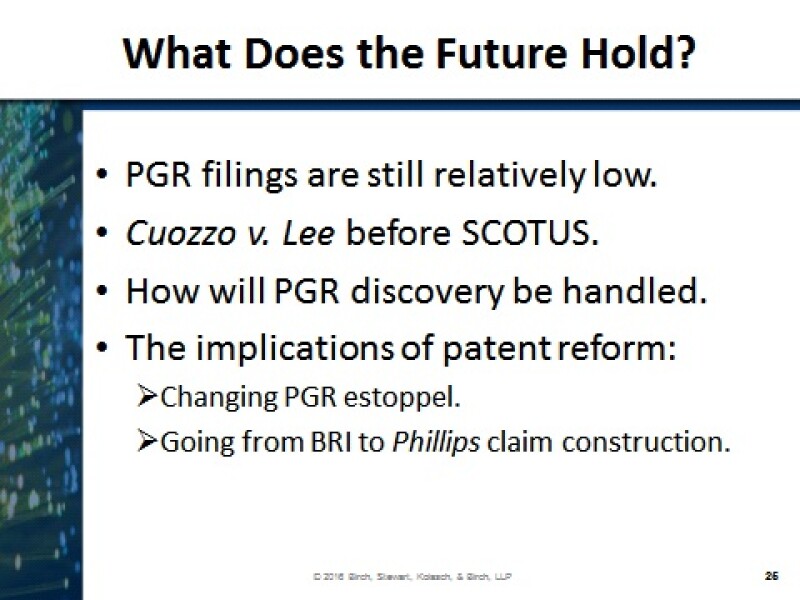
·
Trade secret protection as a means of protecting innovation
The exit interview is very important in making clear what departing obligations are regarding trade secrets. Colin Raufer of The Boeing Company noted: “We bring in our employee agreement and say, ‘You signed this on your first day; today is your last day we are reminding you of your obligations.’ Then I ask them whether they have any proprietary information at home, kind of to say we are looking at them.”
However, companies bringing on employees should also be wary of being given trade secrets, said Daniel Levy of McKool Smith. “Companies need to think about trade secrets in the on-boarding process. You don’t want to be tainted with a trade secret your employee has no right to give to you. The exit process and the on-boarding process are both important.”
Moderator Courtland Reichman of McKool Smith noted the Jawbone trade secrets case “has a procedure I’ve never seen before. It is fascinating in terms of protecting your client.” Boeing’s Raufer explained when the prior employer sued the employees they were able to get an injunction because they had entered into agreements. “The agreements provided that the disclosure of trade secrets would be irreparable harm entitling the prior employer to an injunction. The injunction reads like a wish list for employers.”
Levy added on Jawbone: “I think the message from the case is enforce your rights when you have these agreements, require your employees to do it and specify all the things that could be trade secrets so they are on notice that when you have your exit interview.” Raufer added: “What’s stunning about the case is it’s a current case and what we got – thumb drives – really? Emails to home on last day of work – really? Human nature doesn’t change.”
How to successfully ensure protection for your designs
One topic for debate was Samsung’s petition to the Supreme Court asking it to reassess the damages rule for design patents (cert was granted days after the forum was held). Jeffrey Fougere of at Hewlett Packard Enterprise, commented "it’s a harsh damage statute". He added: "The design patent law has been there over 120 years, so maybe we need to change the law there. One possible avenue for doing so is the Supreme Court might say the article of manufacture is not necessarily the entire phone, that it is only the bezel, or maybe it is only the operating system or something like that."
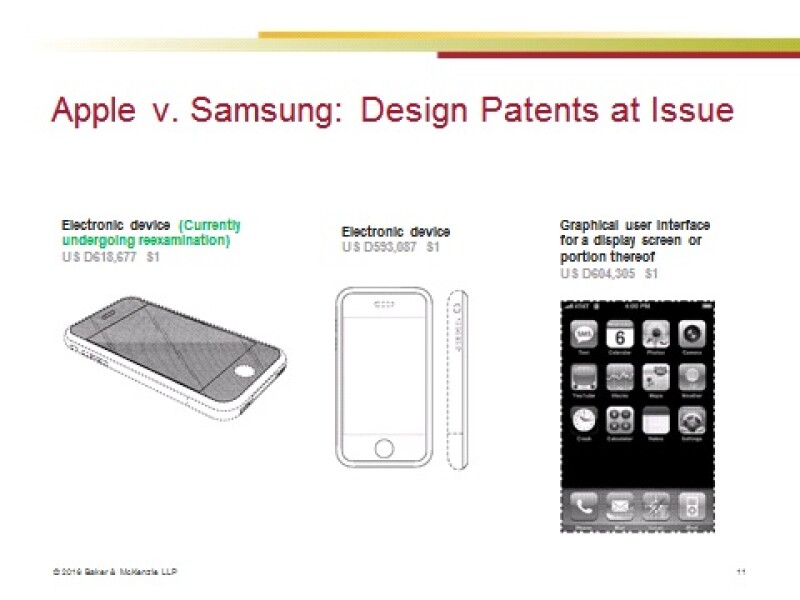
Lisa Meyerhoff of Baker & McKenzie commented: "The best quote about the case is: should the law of the smartphone follow the law of the spoon? The Gorham v White case [in 1871] dealt with the design on the handles of silverware. The folks at Samsung are saying it should not follow the law of the spoon."
Louis Ross of Motion Engine gave an overview of next generation wearables, which will be larger systems with more sophisticated functionality. “Next generation wearables will probably be the next area of these disputes,” he said.
Matt Dushek of Baker & McKenzie explained how to assess whether a design is eligible for protection. Some tips were: just because it can be done another way does not preclude an aspect from being functional; emphasize where design choices are made to achieve a look; emphasize where there is more than one choice that performs the same function; and register everything you can see but don’t pre-empt the entire space.
Meyerhoff compared the similarities and differences of utility v design patents. Similarities are they are enforceable in federal district courts and ITC, claim construction is by judge not jury, and many of the same infringement and invalidity arguments apply. Differences include the term (20 years from filing for utility patents v 15 years from grant for design patents), claims, damages, claim construction, infringement standard and focus.
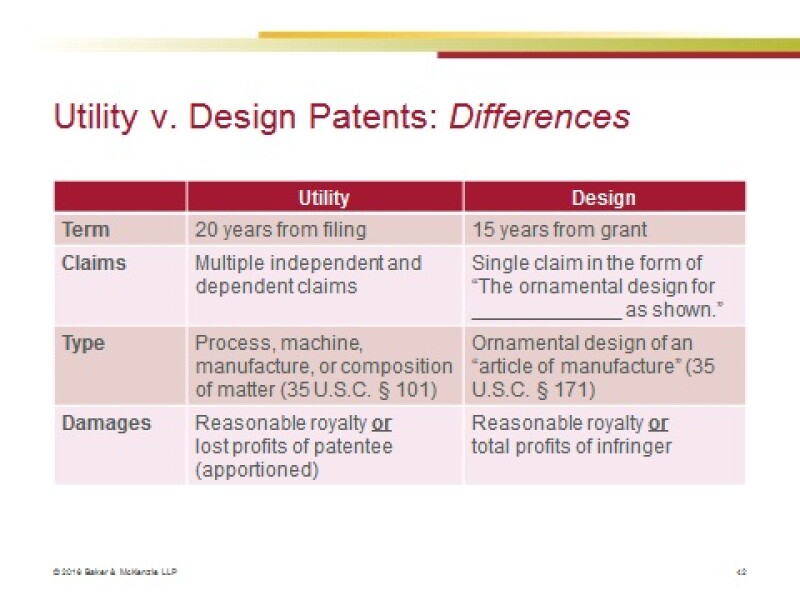
Patent Forum Slide 7
Examining recent litigation trends
Ildiko Mehes of Teva North America noted the effect PTAB is having in pharma. “We see some entities have basically begun to write letters threatening to file IPRs.”
She said Hayman Capital has been aggressive in targeting pharma patents at the PTAB through IPRs. “The ones where it is granted, does the company pay the settlement – pay the extortion – or face losing their patent? More important, how does it affect any Hatch-Waxman litigation that is ongoing?” she asked. “This is clearly a trend.”
The PTAB is also affecting cases in other ways. “There are some judges that are absolutely delighted and grant a stay even if you are thinking about filing an IPR,” said Mehes.
Steven Lieberman of Rothwell Figg Ernst & Manbeck noted IPRs are a “potential strategy for the generics that come to the party late. If you come late, you have to be disruptive.”
Lieberman also noted the PTAB can be a good strategy in challenging NPEs. He noted there are 49 cases in which PTAB has addressed 101 issue on 101 grounds, and zero patents survived out of 49. “Whenever you have a chance to file a CBM in an NPE case that is almost a no brainer,” he said.










